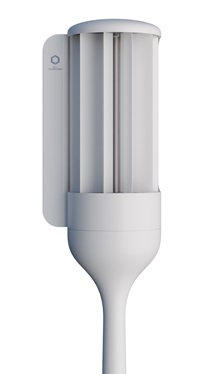Experts and scientists judged it impossible. The new Dutch wind turbine The Blade seems to mock natural laws. And yet, the new home-sized turbine is claimed to produce 2,500 to 3,000 of sustainable electricity yearly (link in Dutch). That’s the amount of electricity the average Dutch household uses each year.

The first model
Directors François Huijbregts and Marcel Naaktgeboren of Cell Technologies developed the turbine. The application for the required NEN-standard has been filed. Saturday, September 28, shareholders and other people involved were present at the presentation of The Blade in Etten-Leur (the Netherlands). Where production should start by the end of 2025 – some 60,000 small wind turbines yearly, possibly even more. An excellent opportunity for private households to produce electricity of their own.
The first model, The BladeX1, is 1.40m high and 60 cm wide. Those dimensions are allowed in almost any Dutch community. The turbine will be mounted on a flagpole next to the outside wall. Just the turbine, 90 cm in height, will extend beyond the roof. This will be allowed almost anywhere. Even more special: the turbine doesn’t produce any sound, it doesn’t vibrate and most probably poses no harm to birds. Those will look upon the equipment as a chimney and circumvent it.
The Blade, anywhere
In principle then, anyone will be able to mount the small turbine on their roof or balcony, or in their garden. On top of that, there are many more opportunities on flat roofs and in farmyards. Or anywhere in the Third World. That isn’t just fantasy: there is a lot of interest in the product, from all over the world.
The Blade doesn’t conform to Betz’s Law; according to this, such a wind turbine could just capture 59.3 percent of the wind’s kinetic energy and transfer it to mechanical energy. In practice, this limit is responsible for a fair number of high wind turbines with three large rotors; and just a few small turbines on rooftops. That is also the reason why people didn’t believe that The Blade would be able to deliver more electricity.
Smart design
For quite a while, the inventors had to keep secret their tricks of the trade. Until they had acquired the patent to their discovery. The Blade ‘circumvents’ Betz’s Law in two, actually three ways. Firstly, on top of the turbine is mounted a plastic hood with holes in it; this turns with the wind direction, as a windvane. Because of this device, the blades of the turbine just capture the wind; they aren’t slowed down at the same time. Moreover, the vane of the hood results in the wind being led through the turbine a second time. In other words: Betz’s Law does apply, but this turbine uses twice the energy contained in the wind.
Another problem is that small wind turbines do not evolve enough strength to power the generator, or alternatively are not able to turn around quickly enough. Huijbregts and Naaktgeboren solved this through transmission. The revolving blades power a large gearwheel. The wheels become smaller successively, until they are being connected to the generator. This will require less torque; the wind turbine will be able to rotate fast enough to produce electricity. At wind-force 4 the turbine already turns at full power. If the wind speed becomes too high, software will turn down the turbine, so that it doesn’t break down.
Tests
We will only be able to tell how much energy The Blade can produce if official tests have been done. The company itself also did measurements, in conditions comparable to those in a residential area. Less optimal, but realistic. The company also develops a larger model, the L1, that will be 2.50 meter high and 1 meter in diameter. Too large for Dutch residential areas, but quite applicable abroad. The L1 would be able to deliver 10,000 kWh yearly.
The Blade has been developed with support from shareholders. Some thousand individuals together came up with almost one million euros of initial capital. They will have the first right to buy the small turbine.
The production
In a years’ time, The Blade will be assembled in a hall in Etten-Leur, the Netherlands. The company will then employ some eighty persons. But production can only start if the company has received the official go-ahead. Without it, no product will be allowed on the European market. This go-ahead will hopefully arrive in January, but at last in July 2025; add another six months before the start of actual production. From fall 2025 onwards, Cell Technologies intends to produce 60,000 Blades yearly. There is a lot of interest.
The turbine will ‘only’ cost € 2.500 – without VAT, mast and installation. In this way, the founders hope also to attract people with somewhat less money. Particularly tenants are not in view of the authorities – these do not participate in sustainability. Cell Technologies hopes to remedy that somewhat. In order for people not just to learn to get fed, so to speak, but also to be taught fishing.
Interesting? Then also read:
Renewable energy system costs – the untold story
Local grid optimization
Solar and wind energy revisited

Prima ,lijk mij echt iets op ons appartement ,goede bezig Chapeau !